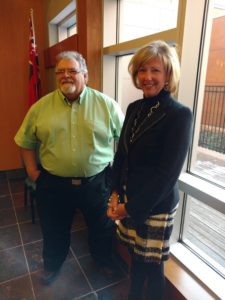Bluewater Health looking to hire First Nation’s hospital navigator

By Colin Graf
SARNIA—First Nations patients at the Sarnia hospital may soon have some extra help finding their way through the complexities of the health system. Bluewater Health is looking to hire a First Nations’ “navigator”, a person who will help arrange culturally-appropriate care and help develop links between the hospital and Indigenous communities in southwestern Ontario, according to hospital officials.
The navigator will be a person who establishes relationships with patients and their families to help them before, during, and after their hospital stay, as well as help train staff in understanding Indigenous culture, says Merv Wilson, Manager of Spiritual Care.
First Nations’ patients are often cared for at Indigenous health centres, rather than urban doctors’ offices. The health centres are not always in close contact with hospitals, leading to a greater change for miscommunications about patients’ conditions, previous treatment, and needs, according to Tanya Baniak, the Indigenous Health Liaison with the Erie-St. Clair Local Health Integration Network (LHIN).
“They may be receiving traditional herbal medicine or other forms of treatment that doctors at the hospital may not know about,” added Baniak.
A hospital navigator, as proposed in Sarnia, would have a foot in both the hospital and community, providing a bridge between the two, explains Laurie Zimmer, vice-president of operations at Bluewater Health.
The navigator will help make sure patients do well after leaving hospital by staying in touch with the people caring for a discharged patient at home to ensure her or his discharge plan is followed, noted Zimmer. A navigator may also look to see if First Nation patients are being re-admitted often for particular reasons and help hospital staff find ways to avoid that problem.
“When they first come to hospital, Indigenous patients often bring more than their personal worries with them,” stated Baniak, who works with the regional Indigenous Health Planning Committee. “Health care providers need to recognize the inherent trauma many First Nations people carry from the history of colonization, and recognize how that may show in doctor-patient relationships. For instance, patients may be reluctant to ask questions of a care provider because they feel intimidated or shamed by the built-in authority in that relationship.”
There can often be other invisible barriers to good health care for Indigenous Canadians that a navigator can help with, says Baniak. For instance, care providers aren’t always aware of transportation problems patients are facing. Doctors, therapists, or office staff are likely to be fairly affluent and have their own vehicles, so they may not stop to think if First Nations’ patients might have complications getting to follow-up appointments. A doctor or other worker may think if First Nations’ patients keep missing appointments it means they don’t care about their health, she suggests.
Simple questions about making convenient appointments, or looking for alternatives to in-office visits need to be addressed, Baniak emphasizes.
“Often, it boils down to creating trust,” believes Baniak. “There are tons of examples, backed by statistics, that when an Indigenous person doesn’t feel cared for in the health care system, that person doesn’t make it back for further appointments.”
Bluewater Health is taking active steps to show sensitivity to First Nations’ culture, according to Wilson and Zimmer.
“We’ve pushed back some boundaries. A year ago, no one was allowed to smudge in this building,” Wilson explains, while Zimmer points to the renovation of a birthing room in the maternity ward, which was completed with advice from First Nations women from the area. The room features indigenous art and was enlarged to make space for ceremonies or for extra family or community members.
“Bluewater Health is expecting to provide training for around 20 staff members to increase their knowledge and awareness of indigenous culture this year,” added Zimmer.
Members of the three local First Nations, Aamjiwnaang (Chippewas of Sarnia), Bkejwanong (Walpole Island First Nation) and the Chippewas of Kettle and Stony Point First Nation, are being invited to work with the hospital to further define the job of the navigator. The hospital also hopes to have indigenous volunteers working at the hospital and possibly First Nations’ board members as well, Zimmer explained.
“We want this to be a representative hospital,” stated Zimmer.
There are six First Nations navigators already working at health care facilities in the Erie-St. Clair Local Health Integration Network area, from Grand Bend on Lake Huron to Windsor, including Sarnia and the city of Chatham.
Baniak notes that the Indigenous health committee wants to facilitate improvements before the end of 2018 in the following five areas:
- reducing health inequities for Indigenous people;
- improving Indigenous patients’ access to health and prevention services;
- improving the health system’s response to Indigenous chronic disease rates;
- expand the availability of mental health and addiction services for Indigenous people; and
- enhancing the quality and availability of reliable information and data for health planning
Groups that have been involved with the planning committee include Aamjiwnaang, Bkejwanong, Kettle and Stony Point, Caldwell First Nation, Delaware First Nation, Moravian of the Thames First Nation, the Sarnia Lambton Native Friendship Centre, the Can-Am Friendship Indian Centre, the Windsor-Essex Métis Nation of Ontario, and the Fiddle & Sash Métis Association.


